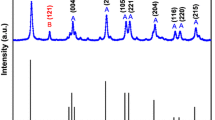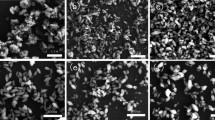Abstract
Titania (TiO2) nanorods have been synthesized with controlled size for dye-sensitized solar cells (DSSCs) via hydrothermal route at low hydrothermal temperature of 100 °C for 24 h. The titania nanorods were characterized using XRD, SEM, TEM/HRTEM, UV-vis Spectroscopy, FTIR and BET specific surface area (S BET), as well as pore-size distribution by BJH. The results indicated that the bulk traps and the surface states within the TiO2 nanorods films have enhanced the efficiency of DSSCs. The size of the titania nanorods was 6.7 nm in width and 22 nm in length. The high surface area can provide more sites for dye adsorption, while the fast photoelectron-transfer channel can enhance the photogenerated electron transfer to complete the circuit. The specific surface area S BET was 77.14 m2 g−1 at the synthesis conditions. However, the band gap energy of the obtained titania nanorods was 3.2 eV. The oriented nanorods with appropriate lengths are beneficial in improving the electron transport property and thus leading to the increase of photocurrent, together enhancing the power conversion efficiency. A nearly quantitative absorbed photon-to-electrical current conversion achieved upon excitation at wave length of 550 nm and the power efficiency was enhanced from 5.6 % for commercial TiO2 nanoparticles Degussa (P25) cells to 7.2 % for TiO2 nanorods cells under AM 1.5 illumination (100 mW cm−2). The TiO2 cells performance was improved due to their high surface area, hierarchically mesoporous structures and fast electron-transfer rate compared with the Degussa (P25).











Similar content being viewed by others
References
T. Tachikawa, M. Fujitsuka, T. Majima, Influences of adsorption on TiO2 photocatalytic one-electron oxidation of aromatic sulfides studied by time-resolved diffuse reflectance spectroscopy. J. Phys. Chem. C 111, 5259 (2007)
G.J. Wilson, G.D. Will, R.L. Frost, S.A. Montgomery, Efficient microwave hydrothermal preparation of nanocrystalline anatase TiO2 colloids. J. Mater. Chem. 12, 1787 (2002)
H. Wang, T. Wang, P. Xu, Effects of substrate temperature on the microstructure and photocatalytic reactivity of TiO2 films. J. Mater. Sci., Mater. Electron. 9, 327 (1998)
I. Gonzalez-Valls, M. Lira-Cantu, Dye sensitized solar cells based on vertically-aligned ZnO nanorods: effect of UV light on power conversion efficiency and lifetime. Energy Environ. Sci. 3, 789 (2010)
Y. Saito, S. Kambe, T. Kitamura, Y. Wada, S. Yanagida, Morphology control of mesoporous TiO2 nanocrystalline films for performance of dye-sensitized solar cells. Sol. Energy Mater. Sol. Cells 83, 1 (2004)
M. Grätzel, Corrigendum to “Conversion of sunlight to electric power by nanocrystalline dye-sensitized solar cells”. J. Photochem. Photobiol. A, Chem. 168, 235 (2004)
L. Gonzalez-G., I. Gonzalez-V., M. Lira-Cantu, A. Barrancoa, A.R. Gonzalez-E., Aligned TiO2 nanocolumnar layers prepared by PVD-GLAD for transparent dye sensitized solar cells. Energy Environ. Sci. 4, 3426 (2011)
M. Adachi, Y. Murata, I. Okada, S. Yoshikawa, Formation of titania nanotubes and applications for dye-sensitized solar cells. J. Electrochem. Soc. 150, 488 (2003)
K. Gopal, M. Karthik Shankar, P. Maggie, O.K. Varghese, C.A. Grimes, Use of highly-ordered TiO2 nanotube arrays in dye-sensitized solar cells. Nano Lett. 6, 215 (2006)
M. Adachi, Y. Murata, J. Takao, J.T. Jiu, M. Sakamoto, F.M. Wang, Highly efficient dye-sensitized solar cells with a titania thin-film electrode composed of a network structure of single-crystal-like TiO2 nanowires made by the “oriented attachment” mechanism. J. Am. Chem. Soc. 126, 14943 (2004)
S. Pavasupree, S. Ngamsinlapasathian, M. Nakajima, Y. Suzuki, S. Yoshikawa, Hydrothermal synthesis, characterization, photocatalytic activity and dye-sensitized solar cell performance of mesoporous anatase TiO2 nanopowders. J. Photochem. Photobiol. A, Chem. 163, 184 (2006)
A. Chemseddine, H. Jungblut, S. Boulmaaz, Investigation of the nanocluster self-assembly process by scanning tunneling microscopy and optical spectroscopy. J. Phys. Chem. 100, 12546 (1996)
R.L. Whetten, J.T. Khoury, M.M. Alvarez, S. Murthy, I. Vezmar, Z.L. Wang, P.W. Stephens, C.L. Cleveland, W.D. Luedtke, U. Landman, Transient photocurrent and photovoltage studies on charge transport in dye sensitized solar cells made from the composites of TiO2 nanofibers and nanoparticles. Adv. Mater. 8, 428 (1995)
E. Hosono, S. Fujihara, K. Kakiuchi, H. Imai, Growth of sub-micrometer-scale rectangular parallelepiped rutile TiO2 films in aqueous TiCl3 solutions under hydrothermal conditions. J. Am. Chem. Soc. 126, 7790 (2004)
T. Peng, D. Zhao, K. Dai, W. Shi, K. Hirao, Synthesis of titanium dioxide nanoparticles with mesoporous anatase wall and high photocatalytic activity. J. Phys. Chem. B 109, 4947 (2005)
E.A. Barringer, H.K. Bowen, High-purity, monodisperse TiO2 powders by hydrolysis of titanium tetraethoxide. Langmuir 1, 414 (1985)
M.M. Rashad, A.E. Shalan, Synthesis and optical properties of titania–PVA nanocomposites. Int. J. Nanopart. 5, 159 (2012)
S. Asal, M. Saif, H. Hafez, S. Mozia, A. Heiak, D. Moszyrisko, M.S.A. Abdel-Mottaleb, Photocatalytic generation of useful hydrocarbons and hydrogen from acetic acid in the presence of lanthanide modified TiO2. Int. J. Hydrog. Energy (2011). doi:10.1016/j.ijhydene.2011.02.066
W. Kongsuebchart, P. Praserthdam, J. Panpranot, A. Sirisuk, P. Supphasrirongjaroen, C. Satayaprasert, Effect of crystallite size on the surface defect of nano-TiO2 prepared via solvothermal synthesis. J. Cryst. Growth 297, 234 (2006)
C.C. Tsai, H. Teng, Structural features of nanotubes synthesized from NaOH treatment on TiO2 with different post-treatments. Chem. Mater. 18, 367 (2006)
Y.V. Kolen’ko, K.A. Kovnir, A.I. Gavrilov, A.V. Garshev, J. Frantti, O.I. Lebedev, B.R. Churagulov, O.G. van Tendeloo, M. Yoshimura, Hydrothermal synthesis and characterization of nanorods of various titanates and titanium dioxide. J. Phys. Chem. B 110, 4030 (2006)
B. O’Regan, M. Grätzel, A low-cost, high-efficiency solar cell based on dye-sensitized colloidal TiO2 films. Nature 353, 737 (1991)
F. Sauvage, D.H. Chen, P. Comte, F.Z. Huang, L.P. Heiniger, Y.B. Cheng, R.A. Caruso, M. Grätzel, Dye-sensitized solar cells employing a single film of mesoporous TiO2 beads achieve power conversion efficiencies over 10 %. ACS Nano 4, 4420 (2010)
J.R. Durrant, S.A. Haque, E. Palomares, Towards optimization of electron transfer processes in dye sensitized solar cells. Coord. Chem. Rev. 248(13–14), 1247 (2004).
B.H. Lee, M.Y. Song, S.Y. Jang, S.M. Jo, S.Y. Kwak, D.Y. Kim, Charge transport characterization of high efficiency dye sensitized solar cells based on electrospun TiO2 nanorod photoelectrodes. J. Phys. Chem. C 113, 21453 (2009)
C. Longo, A.F. Nogueira, M.A. De Paoli, H. Cachet, Solid-state and flexible dye-sensitized TiO2 solar cells: a study by electrochemical impedance spectroscopy. J. Phys. Chem. B 106, 5925 (2002)
M. Grätzel, Photoelectrochemical cells. Nature 414, 338 (2001)
P.K. Khanna, N. Singh, S. Charan, Synthesis of nano-particles of anatase-TiO2 and preparation of its optically transparent film in PVA. Mater. Lett. 61, 4725 (2007)
S.N. Karthick, K. Prabakar, A. Subramania, J.-T. Hong, J.-J. Jang, H.-J. Kim, Preparation, phase transformation and photocatalytic activities of cerium-doped mesoporous titania nanoparticles. Powder Technol. 305, 36 (2011)
T. Peng, D. Zhao, H. Song, C. Yan, Visible light induced photocatalytic activity of rare earth titania nanocomposites. J. Mol. Catal. A, Chem. 238, 119 (2005)
M.M. Rashad, A.E. Shalan, M. Lira-Cantú, M.S.A. Abdel-Mottaleb, Enhancement of TiO2 nanoparticle properties and efficiency of dye-sensitized solar cells using modifiers. Appl. Nanosci. (2012). doi:10.1007/s13204-012-0117-5
K.S.W. Sing, D.H. Everett, R.A.W. Haul, L. Moscou, R.A. Pierotti, J. Rouquerol, T. Siemieniewska, Reporting physisorption data for gas/solid systems with special reference to the determination of surface area and porosity. Pure Appl. Chem. 57, 603 (1985)
J.G. Yu, G.H. Wang, B. Cheng, M.H. Zhou, Effects of hydrothermal temperature and time on the photocatalytic activity and microstructures of bimodal mesoporous TiO2 powders. Appl. Catal. B, Environ. 69, 171 (2007)
M. Saif, M.S.A. Abdel-Mottaleb, Titanium dioxide nanomaterial doped with trivalent lanthanide ions of Tb, Eu and Sm: preparation, characterization and potential applications. Chim. Acta 360, 2863 (2006)
J.G. Yu, L.J. Zhang, B. Cheng, Y.R. Su, Hydrothermal preparation and photocatalytic activity of hierarchically sponge-like macro-/mesoporous titania. J. Phys. Chem. C 111, 10582 (2007)
H. Hafez, M. Saif, M.S.A. Abdel-Mottaleb, Down-converting lanthanide doped TiO2 photoelectrodes for efficiency enhancement of dye-sensitized solar cells. J. Power Sources 196, 5792 (2011)
J. Yu, J. Fana, Z. Li, Dye-sensitized solar cells based on hollow anatase TiO2 spheres prepared by self-transformation method. J. Electrochim. Acta 55, 597 (2010)
K. Fan, W. Zhang, T. Peng, J. Chen, F. Yang, Application of TiO2 fusiform nanorods for dye-sensitized solar cells with significantly improved efficiency. J. Phys. Chem. C 115, 17213 (2011)
Q. Wang, J.-E. Moser, M. Grätzel, Electrochemical impedance spectroscopic analysis of dye-sensitized solar cells. J. Phys. Chem. B 109, 14945 (2005)
J. Bisquert, Chemical capacitance of nanostructured semiconductors: its origin and significance for nanocomposite solar cells. J. Phys. Chem. Chem. Phys. 5, 5360 (2003)
L.Y. Han, N. Koide, Y. Chiba, T. Mitate, Modeling of an equivalent circuit for dye sensitized solar cells. Appl. Phys. Lett. 84, 2433 (2004)
A. Hauch, A. Georg, Diffusion in the electrolyte and charge-transfer reaction at the platinum electrode in dye-sensitized solar cells. Electrochim. Acta 46, 3457 (2001)
L. Qi, Y. Ma, Q. Ouyang, Y. Zhang, L. Li, Y. Chen, The controllable synthesis of chain-like TiO2 networks with multiwalled carbon nanotubes as templates and its application for dye-sensitized solar cells. J. Nanopart. Res. 14, 907 (2012). doi:10.1007/s11051-012-0907-4
F. Fabregat-Santiago, J. Bisquert, E. Palomares, L. Otero, D. Kuang, S.M. Zakeeruddin, M. Grätzel, Correlation between photovoltaic performance and impedance spectroscopy of dye-sensitized solar cells based on ionic liquids. J. Phys. Chem. C 111, 6550–6560 (2007). doi:10.1021/jp066178a
D. Zhao, T. Peng, L. Lu, P. Cai, P. Jiang, Z. Bian, Effect of annealing temperature on the photoelectrochemical properties of dye-sensitized solar cells made with mesoporous TiO2 nanoparticles. J. Phys. Chem. C 112, 8486–8494 (2008). doi:10.1021/jp800127x
J. Qu, X.P. Gao, G.R. Li, Q.W. Jiang, T.Y. Yan, Structure transformation and photoelectrochemical properties of TiO2 nanomaterials calcined from titanate nanotubes. J. Phys. Chem. C 113, 3359–3363 (2009). doi:10.1021/jp810692t
Acknowledgements
This work was financially supported by the Academy of Scientific Research and Technology (ASRT) and Ministry of Scientific Research of Egypt. Ahmed Shalan acknowledges Prof. Monica Lira and her lab in Centre de Investigacio en Nanociencia I Nanotecnologia (Cin2, CSIC), ETSE, Campus UAB, Bellaterra (Barcelona), Spain for their support and helping in pursue part of the experimental section.
Author information
Authors and Affiliations
Corresponding author
Rights and permissions
About this article
Cite this article
Shalan, A.E., Rashad, M.M., Yu, Y. et al. A facile low temperature synthesis of TiO2 nanorods for high efficiency dye sensitized solar cells. Appl. Phys. A 110, 111–122 (2013). https://doi.org/10.1007/s00339-012-7368-6
Received:
Accepted:
Published:
Issue Date:
DOI: https://doi.org/10.1007/s00339-012-7368-6




